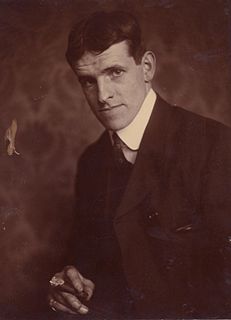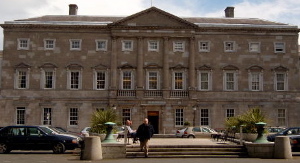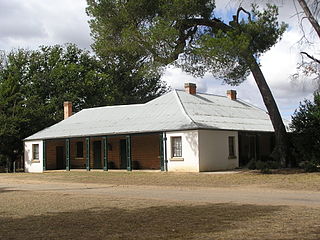
Jack Butler Yeats RHA was an Irish artist and Olympic medalist. W. B. Yeats was his brother.

William Butler Yeats was an Irish poet, dramatist, writer and one of the foremost figures of 20th-century literature. He was a driving force behind the Irish Literary Revival and became a pillar of the Irish literary establishment who helped to found the Abbey Theatre, and in his later years served two terms as a Senator of the Irish Free State.

Isabella Augusta, Lady Gregory was an Irish dramatist, folklorist and theatre manager. With William Butler Yeats and Edward Martyn, she co-founded the Irish Literary Theatre and the Abbey Theatre, and wrote numerous short works for both companies. Lady Gregory produced a number of books of retellings of stories taken from Irish mythology. Born into a class that identified closely with British rule, she turned against it. Her conversion to cultural nationalism, as evidenced by her writings, was emblematic of many of the political struggles to occur in Ireland during her lifetime.

Georgian Dublin is a phrase used in terms of the history of Dublin that has two interwoven meanings:
- to describe a historic period in the development of the city of Dublin, Ireland, from 1714 to the death in 1830 of King George IV. During this period, the reign of the four Georges, hence the word Georgian, covers a particular and unified style, derived from Palladian Architecture, which was used in erecting public and private buildings
- to describe the modern day surviving buildings in Dublin erected in that period and which share that architectural style

Austin Clarke, born in 83 Manor Street, Stoneybatter, Dublin, was one of the leading Irish poets of the generation after W. B. Yeats. He also wrote plays, novels and memoirs. Clarke's main contribution to Irish poetry was the rigour with which he used technical means borrowed from classical Irish language poetry when writing in English.

Camberwell is a suburb of Melbourne, Victoria, Australia, 9 km east of Melbourne's Central Business District. Its local government area is the City of Boroondara. At the 2016 Census, Camberwell had a population of 22,081.
The Irish Literary Revival was a flowering of Irish literary talent in the late 19th and early 20th century.

Frescati House was a Georgian house and estate situated in Blackrock, Dublin. It was built in 1739 for the family of John Hely Hutchinson, the Provost of Trinity College.

Firhouse is an outer suburb of Dublin, in the county of South Dublin, in the south of the traditional County Dublin, Ireland. It developed from a rural village by the River Dodder, with a second settlement, Upper Fir-house, nearby. It is just outside the M50 orbital motorway, and in the postal district of Dublin 24. It is adjacent to Knocklyon and Ballycullen, and close to Tallaght. In the historic divisions of local administration, Firhouse is in the civil parish of Tallaght and the barony of Uppercross.
Redhill Grange or (Redhill) is a purpose-built settlement in Wellingborough, Northamptonshire. It is situated just north from the Redwell area in the market town and eleven miles from the county town Northampton, forming part of the district authority of the borough of Wellingborough, now in North Northamptonshire.

Mountjoy Square is a Georgian garden square in Dublin, Ireland, on the Northside of the city just under a kilometre from the River Liffey. One of five Georgian squares in Dublin, it was planned and developed in the late 18th century by Luke Gardiner, 1st Viscount Mountjoy. It is surrounded on all sides by terraced, red-brick Georgian houses. Construction of the houses began piecemeal in 1792 and the final property was completed in 1818.
Corduff is a northwestern suburb of Dublin, in Fingal, Ireland. It is a part of the wider Blanchardstown area and is part of the Dublin 15 postal district. As of 2016, the electoral division of Blanchardstown-Corduff had a population of 3,871.
Overdale was a small residential district in downtown Montreal that became a famous symbol of the struggle between urban conservationists and land developers.

Riversdale, is a five-part, large-scale late Georgian mansion with superior Federal interior, built between 1801 and 1807. Also known as Baltimore House, Calvert Mansion or Riversdale Mansion, it is located at 4811 Riverdale Road in Riverdale Park, Maryland, and is open to the public as a museum.
Seán Dunne is an Irish businessman and property developer. He is sometimes referred to as "Baron of Ballsbridge" because of his ambitious development project for the Jury's/Berkeley Court hotels site in Ballsbridge. He left Dublin for the United States after the property collapse of 2007 to 2011. He was born in County Carlow, Ireland.

Blood and the Moon is a poem by Irish poet William Butler Yeats written in 1928 and published in the collection The Winding Stair in 1929 before being reprinted in The Winding Stair and Other Poems in 1933. Yeats composed the poem in response to the 1927 assassination of Kevin O'Higgins, the Vice-President of the Free State, whom Yeats had known personally. The poem contains many themes common in Yeats's poems from the 1920s including the "tower", a reference to Thoor Ballylee, which had been the title of a collection of works printed the year before "Blood and the Moon" was published, as well as the "gyre" which had been a major focus of his 1920 poem "The Second Coming".

Riversdale is a heritage-listed house in the early colonial Regency style located in Goulburn, New South Wales, Australia. The house was built in about 1840 and some of the outbuildings were constructed even earlier. The house is listed on the New South Wales State Heritage Register and the property is owned by the National Trust of Australia. It was added to the New South Wales State Heritage Register on 1 March 2002.

Mount St Mary's Convent is a heritage-listed Roman Catholic convent at 50 Grove Street, Toowong, Brisbane, Queensland, Australia. It was built from 1885 to c. 1918. It is also known as Goldicott. It was added to the Queensland Heritage Register on 26 November 1998.

Belcamp House is a Georgian house and former school, situated within a substantial estate off the Malahide Road in Balgriffin in the northern suburbs of Dublin, Ireland. The house was designed by the noted architect James Hoban, who also designed the White House in Washington, D.C. with a similar Oval Office utilising the bow back of the building.













